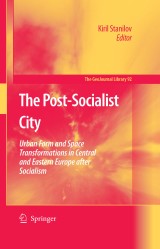Details

The Post-Socialist City
Urban Form and Space Transformations in Central and Eastern Europe after SocialismGeoJournal Library, Band 92
|
213,99 € |
|
| Verlag: | Springer |
| Format: | |
| Veröffentl.: | 13.08.2007 |
| ISBN/EAN: | 9781402060533 |
| Sprache: | englisch |
| Anzahl Seiten: | 496 |
Dieses eBook enthält ein Wasserzeichen.
Beschreibungen
<P>In the large body of literature produced during the last fifteen years on the transformation of Eastern European societies after the fall of communism, studies investigating changes in urban form and structure have been quite rare. Yet a profound reorganization of the manner in which urban space is appropriated has taken place, impacting the life of over 200 million urban residents in the region. The patterns of spatial organization, which have been established during this fairly limited but critical timeframe, are likely to set the direction of future urban development in CEE cities for a long time.</P>
<P>This book focuses on the spatial transformations in the most dynamically evolving urban areas of post-socialist Central and Eastern Europe, linking the restructuring of the built environment with the underlying processes and forces of socio-economic reforms. We hope that the detailed accounts of the spatial transformations in a key moment of urban history in the region will enhance our understanding of the linkages between society and space, adding to the knowledge that is needed for resolving the difficult challenges facing cities throughout the globe in the beginning of the twenty-first century.</P>
<P>This book focuses on the spatial transformations in the most dynamically evolving urban areas of post-socialist Central and Eastern Europe, linking the restructuring of the built environment with the underlying processes and forces of socio-economic reforms. We hope that the detailed accounts of the spatial transformations in a key moment of urban history in the region will enhance our understanding of the linkages between society and space, adding to the knowledge that is needed for resolving the difficult challenges facing cities throughout the globe in the beginning of the twenty-first century.</P>
Taking stock of post-socialist urban development: A recapitulation.- Regional Development Trends.- Political reform, economic development, and regional growth in post-socialist Europe.- Regional growth dynamics in Central and Eastern Europe in the socio-economic and geographic context of a post-socialist reality.- Urbanization patterns in Russia in the post-Soviet era.- Non-Residential Development.- The restructuring of non-residential uses in the post-socialist metropolis.- Land market, commercial real estate, and the remolding of Moscow’s urban fabric.- Office development and post-communist city formation: The case of Prague.- The evolution of industrial areas in Budapest after 1989.- Residential Development.- Housing trends in Central and Eastern European cities during and after the period of transition.- Social and spatial consequences of the restitution of real estate.- The perils of post-socialist transformation: Residential development in Sofia.- Upscale housing in post-Soviet Moscow and its environs.- The Evolution of Public Space.- Democracy, markets, and public space in the transitional societies of Central and Eastern Europe.- Public space in the “blue cities” of Russia.- The peculiar history of (post) communist public places and spaces: Bucharest as a case study.- Urban transport in the Baltic republics.- Public Policy and Urban Development.- Urban development policies in Central and Eastern Europe during the transition period and their impact on urban form.- Belgrade’s post-socialist urban evolution: Reflections by the actors in the development process.- Urban development, legislation, and planning in post-socialist Zagreb.- Planning the Post-Socialist City.- Urban planning and the challenges of the post-socialist transformation.- The post-socialist urban restructuring of Ljubljana: Strengthening identity.- Urban futures: Strategic planning in post-socialist Europe.- Urban and regional planning in Central and Eastern European countries – from EU requirements to innovative practices.
<P>In the large body of literature produced during the last fifteen years on the transformation of Eastern European societies after the fall of communism, studies investigating changes in urban form and structure have been quite rare. Yet a profound reorganization of the manner in which urban space is appropriated has taken place, impacting the life of over 200 million urban residents in the region. The patterns of spatial organization, which have been established during this fairly limited but critical timeframe, are likely to set the direction of future urban development in CEE cities for a long time.</P>
<P></P>
<P>This book focuses on the spatial transformations in the most dynamically evolving urban areas of post-socialist Central and Eastern Europe, linking the restructuring of the built environment with the underlying processes and forces of socio-economic reforms. We hope that the detailed accounts of the spatial transformations in a key moment of urban history in the regionwill enhance our understanding of the linkages between society and space, adding to the knowledge that is needed for resolving the difficult challenges facing cities throughout the globe in the beginning of the twenty-first century.</P>
<P></P>
<P>This book focuses on the spatial transformations in the most dynamically evolving urban areas of post-socialist Central and Eastern Europe, linking the restructuring of the built environment with the underlying processes and forces of socio-economic reforms. We hope that the detailed accounts of the spatial transformations in a key moment of urban history in the regionwill enhance our understanding of the linkages between society and space, adding to the knowledge that is needed for resolving the difficult challenges facing cities throughout the globe in the beginning of the twenty-first century.</P>
Focus on the evolution of urban form in CEE cities after socialism, an under-explored subject Wide geographic coverage
Diese Produkte könnten Sie auch interessieren:

Observing Systems for Atmospheric Composition

von: Guido Visconti, Pietro Di Carlo, W. Brune, M. Schoeberl, Andreas Wahner

149,79 €















